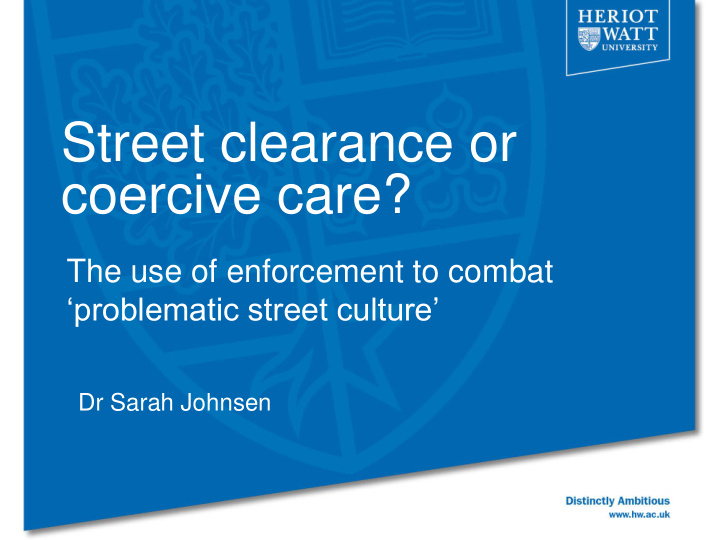



Street clearance or coercive care? The use of enforcement to combat ‘problematic street culture’ Dr Sarah Johnsen
Use of Enforcement in England • As visibility of rough sleeping decreased, concern mounted re ‘hard core’ remaining, esp. street drinkers and those who beg • Led use ↑ of (‘hard’ and soft’) enforcement, e.g.: • Anti-social Behaviour Orders (ASBOs) • Arrests for begging (Vagrancy Act 1824) • Designated Public Places Orders (DPPOs) • Designing out (e.g. gating, removing seating) • Degree to which support is integrated varies (usually > for ‘hard’ measures) 2
Study Aims and Methods • Aim: to assess impact of enforcement interventions on welfare • Methods: case studies in 5 cities, incl.: • Interviews with ‘support providers’ and ‘enforcement agents’ (n=82) • Interviews/focus groups with local residents and business proprietors (n=27) • Interviews/focus groups with people currently/recently begging, street drinking, rough sleeping (n=66) 3
Impacts of Enforcement • Strategies deemed ‘effective’ by LAs • Impacts on street pop’n mixed • Potential responses : 1. engage with support and/or modify behaviour ; 2. continue participation in street activities (with attendant risk of increasingly severe punitive outcomes); 3. continue participation in a street lifestyle elsewhere (‘ geographical displacement ’); or 4. adopt alternative means of funding addiction (‘ activity displacement ’) • Of these, only #1 benefits street pop’n (or wider public) • Responses are highly unpredictable (‘high risk’ strategy) ... theoretical implications...? 4
Revanchism • Term coined by David Smith to connote ‘vengeance’ of cities intent on eradicating undesirables • Increasing control over marginalised groups to benefit of gentrifiers / upper classes • Highly emotive language used by proponents: ‘ annihilation’, ‘ genocidal politics’ (Mitchell, 2001) • • ‘extermination’, ‘erasure’ ( Amster, 2003) • Commentaries based almost exclusively on critique of principles and politics of ‘punitive turn’ cf. articulation (and contestation) of measures used 5
Revanchist Expulsion of the Deviant ‘Other’...? • On first appearance, yes… • Govt. rhetoric has clear revanchist overtones • street popn. portrayed as blight on society taking over from (pro-social?) majority: [We will] shift the balance from the minority that spread fear and distress to the majority that want to win back their communities for themselves and their children. (Home Office, no date, p.1, emph. added) • ascribed as deviant and service resistant: There are places for rough sleepers at night, there is support and treatment available for their health needs and drug habits, and there are benefits available to pay for food and rent. The reality is that the majority of people who beg are doing so to sustain a drug habit… (Home Office, 2003, p.47) • Discretionary policing - targeted at people disturbing desired aesthetic • Displacement of activities 6
Not Just About Aesthetics? Preventing Harm • Common assumption that street popn . doesn’t present credible threat to general public … but is excluded on basis of primitive fears of Otherness • But, evidence that enforcement is, in part, reaction to ‘real’ negative impact where street activity is concentrated • Violence/aggression usually confined to street popn., but some community reps threatened • Drinking schools as camouflage for robbery/dealing • Taxing and bullying common • ‘Hardest’ forms generally targeted at individuals having most extreme negative impact • Many street popn. members supportive of enforcement – to safeguard own wellbeing and public compassion 7
Coercive Care for the Vulnerable ‘Other’? - 1 • Initiatives underpinned, in part, by concern for welfare of vulnerable individuals • Correlation between begging earnings and drug/alcohol consumption • Over-representation of street popn. in drug-related deaths • Police ‘turning a blind eye’ to street culture; reluctance to arrest for ‘passive’ begging • Power to arrest rough sleepers rarely deployed • Escalating enforcement and integration of support • ‘Hard’ measures (integrated with tailored support) sometimes lead to positive outcomes (“my ASBO saved my life”) 8
Coercive Care for the Vulnerable ‘Other’? - 2 • ‘Conversion’ of support providers: acceptance that in extreme circumstances, prioritisation of welfare over liberty may be justified • Significant public sympathy; little evidence of ‘vengeful’ attitudes • Approve most of interventions integrated with support • Condemnation of enforcement targeted at those ‘only’ sleeping rough • Resistance to alternative giving campaigns • Strong opposition to attempts to criminalise soup runs 9
Conclusion • Motivations and outcomes of enforcement are complex ethically • Underpinned by complex set of self-regarding and compassionate motives; often described in ambivalent terms • Little evidence of vengeful/ genocidal politics • Both positive and negative outcomes for those affected; high risk • Need to guard against viewing responses to street culture through ‘default’ revanchist lens • Need for more sophisticated understanding of: • Moral frameworks employed in justifying/ opposing enforcement (i.e. how weight indiv. liberty and welfare) • Factors promoting/ impeding behaviour change (and ‘recovery’) on part of street pop’n members 10
Recommend
More recommend